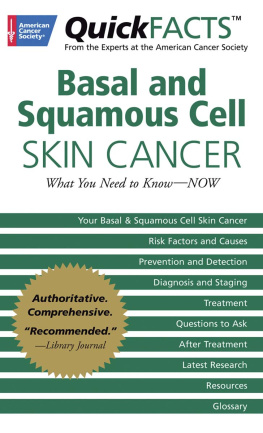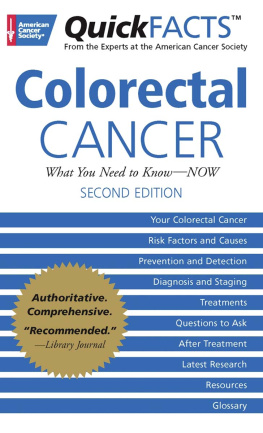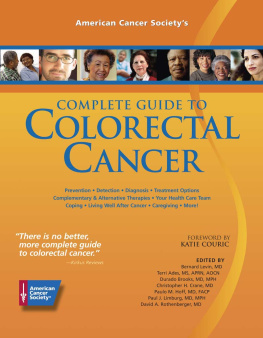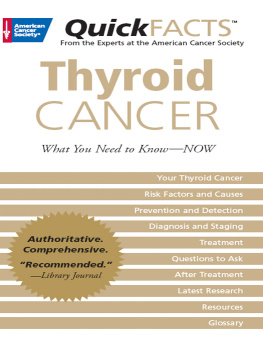

Published by the American Cancer Society/Health Promotions 250 Williams Street NW, Atlanta, Georgia 30303 USA
Copyright 2012 American Cancer Society
All rights reserved. Without limiting the rights under copyright reserved above, no part of this publication may be reproduced, stored in or introduced into a retrieval system, or transmitted in any form or by any means (electronic, mechanical, photocopying, recording, or otherwise) without the prior written permission of the publisher.
For permission to reprint any materials from this publication, contact the publisher at .
Printed in the United States of America Cover designed by Jill Dible, Atlanta, GA Composition by Graphic Composition, Inc.
5 4 3 2 1 12 13 14 15 16
Library of Congress Cataloging-in-Publication Data
Basal and squamous cell skin cancer : what you need to knownow / from the experts at the American Cancer Society.
p. cm.(Quick facts)
Includes bibliographical references and index.
ISBN 978-1-60443-039-4 (pbk. : alk. paper)
ISBN 1-60443-039-7 (pbk. : alk. paper)
1. Basal cell carcinomaPopular works. 2. Squamous cell carcinomaPopular works. I. American Cancer Society. RC280.S5B364 2012 616.99477dc22
2011009547
Quantity discounts on bulk purchases of this book are available. Book excerpts can also be created to fit specific needs. For information, please contact the American Cancer Society, Health Promotions Publishing, 250 Williams Street NW, Atlanta, GA 30303-1002, or send an e-mail to trade.sales@cancer.org.
A Note to the Reader
This information represents the views of the doctors and nurses serving on the American Cancer Societys Cancer Information Database Editorial Board. These views are based on their interpretation of studies published in medical journals, as well as their own professional experience.
The treatment information in this book is not official policy of the Society and is not intended as medical advice to replace the expertise and judgment of your cancer care team. It is intended to help you and your family make informed decisions, together with your doctor.
Your doctor may have reasons for suggesting a treatment plan different from these general treatment options. Dont hesitate to ask him or her questions about your treatment options.
For more information, contact your American Cancer Society at 800-227-2345 or cancer.org.
TABLE OF CONTENTS
Your Skin Cancer
What Is Cancer?
The body is made up of hundreds of millions of living cells. Normal body cells grow, divide, and die in an orderly fashion. During the early years of a persons life, normal cells divide faster to allow the person to grow. After the person becomes an adult, most cells divide only to replace worn-out or dying cells or to repair injuries.
Cancer begins when cells in a part of the body start to grow out of control. There are many kinds of cancer, but they all start because of out-of-control growth of abnormal cells.
Cancer cell growth is different from normal cell growth. Instead of dying, cancer cells continue to grow and form new, abnormal cells. Cancer cells can also invade other tissues, something that normal cells cannot do. Growing out of control and invading other tissues are what makes a cell a cancer cell.
Cells become cancer cells because of damage to DNA. DNA is in every cell and directs all its actions. In a normal cell, when DNA is damaged, the cell either repairs the damage or the cell dies. In cancer cells, the damaged DNA is not repaired, but the cell does not die like it should. Instead, this cell goes on making new cells that the body does not need. These new cells will all have the same damaged DNA as the first cell.
People can inherit damaged DNA, but most DNA damage is caused by mistakes that happen while the normal cell is reproducing or by something in the environment. Sometimes the cause of the DNA damage is something obvious, such as cigarette smoking. Often, however, no clear cause is found.
In most cases, the cancer cells form a tumor. Some cancers, such as leukemia, rarely form tumors. Instead, these cancer cells involve the blood and blood-forming organs and circulate through other tissues where they grow.
Cancer cells often travel to other parts of the body, where they begin to grow and form new tumors that replace normal tissue. This process is called metastasis. It happens when the cancer cells get into the bloodstream or lymph vessels of the body.
No matter where a cancer may spread, it is always named for the place where it started. For example, breast cancer that has spread to the liver is still called breast cancer, not liver cancer. Likewise, prostate cancer that has spread to the bone is metastatic prostate cancer, not bone cancer.
Different types of cancer can behave very differently. For example, lung cancer and breast cancer are very different diseases. They grow at different rates and respond to different treatments. That is why people with cancer need treatment that is aimed at their particular kind of cancer.
Not all tumors are cancerous. Tumors that are not cancer are called benign. Benign tumors can cause problemsthey can grow very large and press on healthy organs and tissues. But they cannot grow into other tissues. Because they cannot invade other tissues, they also cannot metastasize, or spread, to other parts of the body. These tumors are almost never life threatening.
What Are Basal and Squamous Cell Skin Cancers?
To understand basal and squamous cell skin cancers, it helps to know about the normal structure and function of the skin.
Normal Skin
The skin is the largest organ in your body. It does several different things:
- covers the internal organs and protects them from injury
- serves as a barrier to germs such as bacteria
- prevents the loss of too much water and other fluids
- helps control body temperature
The skin has the following 3 layers:

Epidermis
The top layer of skin is the epidermis. The epidermis is thin, averaging only 0.2 millimeters (mm) thick (about 1/100 of an inch). It protects the deeper layers of skin and the organs of the body from the environment.
Keratinocytes are the main cell type of the epidermis. These cells make an important protein called keratin, which gives the skin strength and flexibility and makes the skin waterproof.
The epidermis itself is made up of 3 sublayers. The outermost part of the epidermis is called the stratum corneum, or horny layer. It is composed of dead keratinocytes that are continually shed as new cells form. The cells in this layer are called squamous cells because of their flat shape.
Next page

















